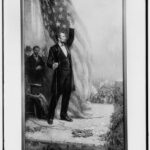What Do Owls Sound Like At Night? The diverse sounds of owls at night are a fascinating aspect of nature, offering a symphony of hoots, trills, and screeches that can help you identify different species, and at streetsounds.net, you can immerse yourself in this soundscape with our extensive library of owl sounds and urban soundscapes. By exploring the world of owl vocalizations, you can enhance your understanding of these creatures and even incorporate their unique sounds into your creative projects, blending wildlife sounds with the pulse of the city. Delve deeper into the world of owl sounds and discover soundscapes for music production and field recording techniques.
1. Owl Sound Essentials: Understanding Nocturnal Vocalizations
Owls vocalize for various reasons, mirroring other birds: territorial claims and defense, mate attraction, and intercommunication. Identifying owl calls becomes especially crucial due to their nocturnal habits, making them more often heard than seen.
Understanding owl sounds at night starts with recognizing that each call serves a specific purpose. From the deep hoot of the Great Horned Owl to the screech of the Barn Owl, these sounds are integral to their survival and social interactions. According to research from Cornell University’s Ornithology Lab, effective communication is crucial for owls, especially in dense forest environments.
1.1. Why Do Owls Hoot and Call at Night?
Owls hoot and call at night primarily to communicate with each other. This can include marking territory, attracting a mate, or warning of danger.
Owls, being nocturnal creatures, rely heavily on auditory signals. These calls are vital for navigation, hunting, and maintaining social structure. Studies from the University of Michigan’s School for Environment and Sustainability indicate that the complexity and variety of owl calls can provide insights into their social dynamics and ecological roles. The hooting and calling are optimized for nocturnal conditions, allowing the sounds to travel farther and be heard more distinctly in the quiet of the night.
1.2. Cultural and Historical Significance of Owl Sounds
Owl sounds carry cultural and historical weight beyond Halloween associations. In North America, many Indigenous cultures interpret owl calls as ill omens, while Harriet Tubman utilized owl call imitations as signals on the Underground Railroad.
The cultural significance of owl sounds varies widely across different societies. Some cultures view owls as symbols of wisdom and knowledge, while others associate them with death and the supernatural. A study by the Smithsonian Institution’s National Museum of Natural History explores the diverse interpretations of owl sounds across various cultures, highlighting their profound impact on folklore and mythology. These sounds have been woven into the fabric of human culture, influencing art, literature, and spiritual beliefs.
1.3. Best Times to Hear Owl Sounds
Prime owl-listening times occur during winter—January and February—when owls claim territories and seek mates; however, owl sounds can be heard year-round at dawn and dusk, when their active periods overlap with ours.
The best time to listen for owls is during their breeding season, which typically occurs in late winter and early spring. During this period, owls are more vocal as they establish territories and attract mates. Environmental factors such as weather conditions and habitat type can also influence the audibility of owl sounds. Research from the National Audubon Society suggests that clear, calm nights are ideal for hearing owl calls, as sound travels farther and is less likely to be disrupted by wind or other environmental noises.
2. Eastern Screech-Owl: The Whinnying Call
 Eastern Screech-Owl perched in a tree
Eastern Screech-Owl perched in a tree
Eastern Screech-Owls make two primary calls: a descending, horse-like whinny for territorial defense and a drawn-out trill on a single pitch for mate attraction and familial contact. Although common and adaptable, Eastern Screech-Owls face population declines in some areas.
These owls thrive in suburban neighborhoods, making their calls a familiar sound to many. According to the U.S. Geological Survey, Eastern Screech-Owls are highly adaptable and can survive in a variety of habitats, from urban parks to rural woodlands. Their ability to adapt to human-altered landscapes has contributed to their widespread distribution across the eastern United States. By visiting streetsounds.net, you can hear examples of their unique calls and learn more about their habitat preferences.
2.1. Identifying Eastern Screech-Owl Calls
Eastern Screech-Owl calls are unique and distinct, making them relatively easy to identify. The descending whinny and extended trill serve different purposes, allowing you to distinguish between territorial displays and mating calls.
The whinny call is a descending series of notes that sounds similar to a horse’s whinny, while the trill is a continuous, even-pitched sound. According to the Cornell Lab of Ornithology, these calls are often used in combination, with the whinny serving as a warning and the trill as a means of maintaining contact. Understanding these nuances can help you better interpret the behavior of these owls in their natural environment.
2.2. Habitat and Distribution
Listen for Eastern Screech-Owls almost anywhere in the U.S. east of the Rockies, where they thrive in diverse habitats, though their populations are declining in some areas.
Eastern Screech-Owls are found in a wide range of habitats, including forests, woodlands, and suburban areas. Their adaptability has allowed them to colonize many urban and suburban environments, where they often nest in tree cavities or nest boxes. Research from the University of Minnesota’s Raptor Center indicates that providing suitable nesting sites can help support local populations of Eastern Screech-Owls, especially in areas where natural tree cavities are scarce.
3. Barred Owl: “Who Cooks For You?”
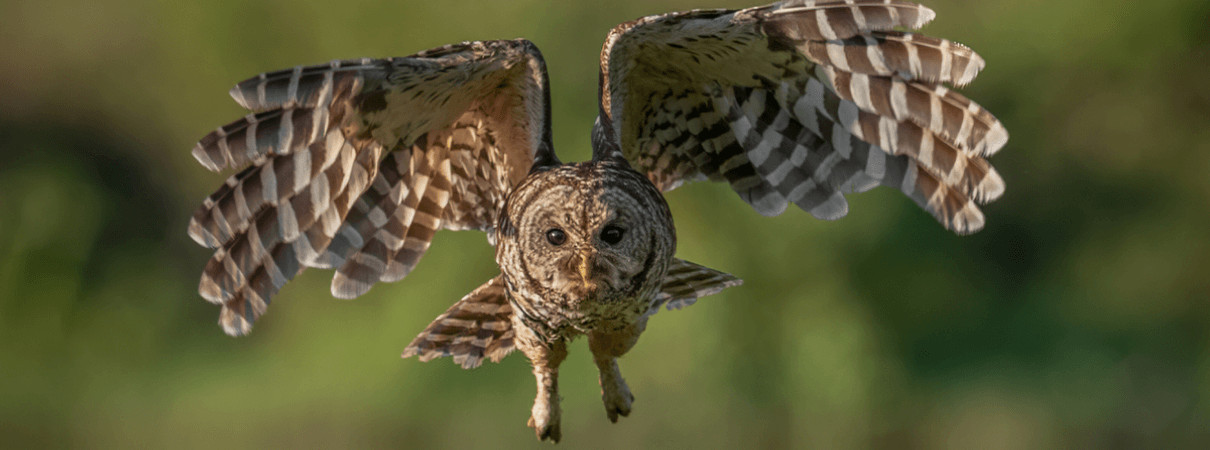 Barred Owl perched in a tree
Barred Owl perched in a tree
Barred Owls are known for their distinctive call that sounds like “Who cooks for YOU? Who cooks for YOU all?” Pairs may also engage in raucous duets featuring cackles, hoots, caws, and gurgles. Unlike many owls, Barred Owls are frequently heard during the day.
These vocal birds are common in the eastern U.S. and have expanded into the Northwest, competing with the Threatened Northern Spotted Owl. According to the U.S. Forest Service, the expansion of Barred Owls into the Northwest has had significant ecological consequences, including the displacement and hybridization of Northern Spotted Owls. Understanding the vocalizations of Barred Owls can help researchers track their movements and assess their impact on native species.
3.1. Distinctive Vocalizations
The Barred Owl’s vocal repertoire includes a variety of sounds, from the classic “Who cooks for YOU?” to more complex duets and calls. Recognizing these sounds can help you identify Barred Owls in their natural habitat.
The “Who cooks for YOU?” call is a series of hoots that typically consists of eight notes, with the emphasis on the last syllable. According to Birds of the World, Barred Owls also produce a variety of other vocalizations, including barks, screams, and growls, which they use to communicate with each other and defend their territory. These sounds can vary depending on the context and the individual owl, making it important to listen carefully and consider the surrounding environment when identifying Barred Owl calls.
3.2. Habitat and Range
Common in the eastern U.S., Barred Owls have moved into the Northwest, impacting the Threatened Northern Spotted Owl, illustrating the importance of understanding owl sounds for ecological research.
Barred Owls are found in a variety of habitats, including forests, swamps, and woodlands. They are particularly common in mature forests with dense canopies and abundant prey. The expansion of Barred Owls into the Northwest has raised concerns about their impact on native species, particularly the Northern Spotted Owl. Research from the University of Washington indicates that Barred Owls compete with Northern Spotted Owls for food and nesting sites, leading to declines in Spotted Owl populations.
4. Great Horned Owl: The Quintessential Hoot
 Eastern Screech-Owl perched in a tree
Eastern Screech-Owl perched in a tree
The Great Horned Owl is the quintessential hooting owl of the United States, often featured in TV shows and movies. Found throughout North and South America, they are adaptable to various habitats, including cities, but are experiencing a gradual decline.
These iconic owls are a symbol of the North American wilderness, with their deep, resonant hoots echoing through the night. According to the National Wildlife Federation, Great Horned Owls are highly adaptable and can thrive in a variety of environments, from dense forests to open fields. However, their populations have declined by around 33 percent over the past five decades, highlighting the need for conservation efforts to protect these magnificent birds.
4.1. Identifying the Great Horned Owl’s Hoot
The deep, resonant hoot of the Great Horned Owl is unmistakable, making it one of the easiest owl calls to identify. Its presence in media further cements its recognition.
The Great Horned Owl’s hoot typically consists of four to five deep, resonant notes that sound like “hoo-h’HOO-hoo-hoo.” According to the Cornell Lab of Ornithology, these hoots are often used to establish territory and attract mates, and they can be heard from miles away on a clear night. The consistency and depth of the Great Horned Owl’s hoot make it a reliable indicator of its presence in a given area.
4.2. Conservation Status and Threats
Despite their adaptability, Great Horned Owls are experiencing population declines, emphasizing the importance of conservation efforts to protect these iconic birds.
Great Horned Owls face a variety of threats, including habitat loss, pesticide use, and collisions with vehicles and power lines. Conservation efforts aimed at protecting and restoring their habitat are essential to ensure their long-term survival. Research from the Audubon Society suggests that reducing pesticide use and promoting responsible land management practices can help mitigate the threats facing Great Horned Owls and other bird species.
5. Barn Owl: The Bloodcurdling Shriek
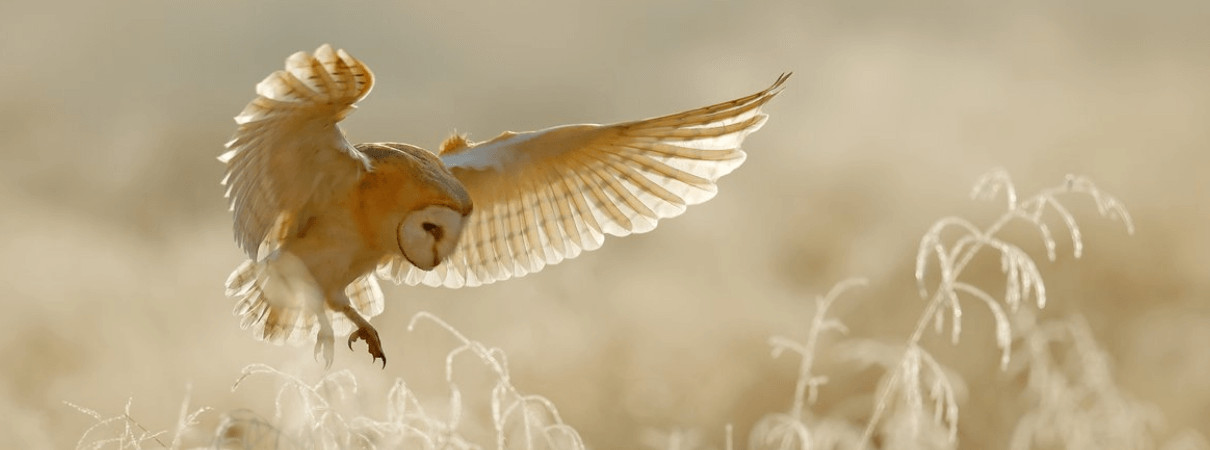 Barn Owl flying at night
Barn Owl flying at night
Barn Owls emit a bloodcurdling shriek that resembles a horror movie scream, used for communication and warning. The most widespread owl species, found on every continent except Antarctica, Barn Owls are vulnerable to collisions with cars, though their populations are generally stable.
These owls are known for their distinctive heart-shaped face and ghostly appearance, making them a symbol of mystery and intrigue. According to the Barn Owl Trust, Barn Owls are highly specialized predators that rely on their exceptional hearing to locate prey in complete darkness. Their bloodcurdling shriek is a testament to their unique adaptations and their ability to thrive in a variety of environments. By listening to examples of their calls on streetsounds.net, you can gain a better appreciation for these remarkable creatures.
5.1. The Barn Owl’s Unique Scream
The Barn Owl’s shriek is unlike any other owl call, making it easily identifiable and serving as a vital means of communication.
The Barn Owl’s shriek is a high-pitched, rasping sound that can be heard from a considerable distance. According to the Cornell Lab of Ornithology, these shrieks are used to communicate with other Barn Owls, particularly during the breeding season, and to warn potential threats. The intensity and frequency of the shrieks can vary depending on the context and the individual owl, making it a complex and nuanced form of communication.
5.2. Worldwide Distribution
Barn Owls’ presence on every continent except Antarctica highlights their adaptability, though they face specific threats like collisions with cars.
Barn Owls are found in a wide range of habitats, including grasslands, farmlands, and urban areas. Their ability to adapt to human-altered landscapes has contributed to their widespread distribution, but it has also made them vulnerable to collisions with vehicles and other hazards. Conservation efforts aimed at reducing these threats are essential to ensure the long-term survival of Barn Owl populations.
6. Burrowing Owl: Ground-Dwelling Sounds
 Eastern Screech-Owl perched in a tree
Eastern Screech-Owl perched in a tree
Burrowing Owls live in and on the ground, with a main call of a high-pitched “coo cooooo,” used by males to woo mates and defend territory. Found in grassland and arid habitats throughout North and South America, these owls are declining and considered a species of conservation concern.
These owls are unique among owl species for their ground-dwelling habits, often nesting in abandoned burrows dug by prairie dogs or other animals. According to the U.S. Fish and Wildlife Service, Burrowing Owls are declining throughout their range due to habitat loss, pesticide use, and other factors. Conservation efforts aimed at protecting and restoring their habitat are essential to ensure their long-term survival.
6.1. Identifying the “Coo Cooooo” Call
The high-pitched “coo cooooo” call of the Burrowing Owl is distinct from other owl calls, reflecting their unique ground-dwelling lifestyle.
The “coo cooooo” call of the Burrowing Owl is a soft, melodious sound that is often described as being similar to a dove’s coo. According to the Cornell Lab of Ornithology, these calls are used by males to attract mates and defend their territory, and they can be heard throughout the breeding season. The high-pitched nature of the call is well-suited for the open grasslands and arid habitats where Burrowing Owls are found.
6.2. Habitat and Conservation
Burrowing Owls’ declining populations underscore the need for conservation efforts focused on protecting their grassland and arid habitats.
Burrowing Owls are found in a variety of grassland and arid habitats, including prairies, pastures, and deserts. They are highly dependent on the presence of burrowing animals, such as prairie dogs, to provide them with nesting sites. Conservation efforts aimed at protecting and restoring these habitats are essential to ensure the long-term survival of Burrowing Owl populations.
7. Western Screech-Owl: Bouncing Ball Hoots
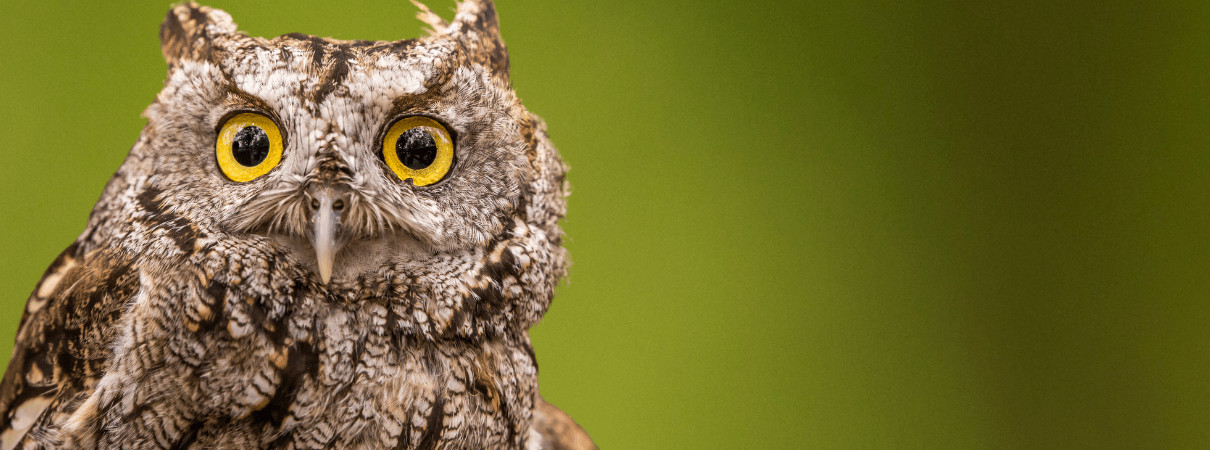 Western Screech Owl perched on a tree
Western Screech Owl perched on a tree
Western Screech-Owls, almost identical to their eastern counterparts, produce a series of hoots that speed up toward the end, like a bouncing ball. Found west of the Rockies, these owls are generally doing well, though one subspecies is listed as Endangered in Canada.
These owls are a common sight in the western United States, often found in woodlands, forests, and suburban areas. According to the Western Screech-Owl Project, these owls are highly adaptable and can thrive in a variety of environments, as long as they have access to suitable nesting sites and prey. Their bouncing ball hoots are a familiar sound to many residents of the western states, and they serve as a reminder of the rich biodiversity of the region.
7.1. Differentiating from Eastern Screech-Owl
Despite their visual similarities, the Western Screech-Owl’s call, resembling a bouncing ball, sets it apart from the Eastern Screech-Owl’s whinny or trill.
The Western Screech-Owl’s call is a series of hoots that gradually increase in speed and intensity, creating the impression of a bouncing ball. According to the Cornell Lab of Ornithology, this call is used to establish territory and attract mates, and it is most commonly heard during the breeding season. The distinctive nature of the call makes it a reliable indicator of the presence of Western Screech-Owls in a given area.
7.2. Range and Conservation Status
Western Screech-Owls’ overall success highlights the importance of habitat preservation, especially for vulnerable subspecies along the Pacific coast.
Western Screech-Owls are found throughout the western United States, from the Rocky Mountains to the Pacific coast. They are generally doing well, but one subspecies, the Pacific Coast Western Screech-Owl, is listed as Endangered in Canada. Conservation efforts aimed at protecting and restoring their habitat are essential to ensure the long-term survival of these owls.
8. Northern Saw-whet Owl: The Saw-Sharpening Sound
 Eastern Screech-Owl perched in a tree
Eastern Screech-Owl perched in a tree
Northern Saw-whet Owls get their name from a call that resembles a saw being sharpened on a whetstone. These tiny owls prefer coniferous forests and are found in many parts of North America. Their secretive and nocturnal behaviors make them hard to study, though populations are declining.
These owls are among the smallest owl species in North America, with a body length of only 7 to 8 inches. According to the U.S. Forest Service, Northern Saw-whet Owls are highly dependent on mature forests with dense canopies and abundant prey. Their secretive and nocturnal habits make them difficult to study, but research suggests that their populations are declining due to habitat loss and other factors.
8.1. Identifying the Saw-Sharpening Call
The Northern Saw-whet Owl’s call, reminiscent of a saw being sharpened, is a unique identifier, reflecting its distinctive vocalization.
The Northern Saw-whet Owl’s call is a series of high-pitched, monotone toots that sound like a saw being sharpened on a whetstone. According to the Cornell Lab of Ornithology, these calls are used by males to announce their presence on their territory and attract mates, and they are most commonly heard during the breeding season. The distinctive nature of the call makes it a reliable indicator of the presence of Northern Saw-whet Owls in a given area.
8.2. Habitat and Declining Populations
Northern Saw-whet Owls’ preference for coniferous forests and declining populations highlight the need for habitat conservation and further research into their secretive behaviors.
Northern Saw-whet Owls are found in a variety of forest types, but they prefer coniferous forests with dense canopies and abundant prey. They are highly dependent on the presence of mature trees with cavities for nesting, and they are vulnerable to habitat loss and fragmentation. Conservation efforts aimed at protecting and restoring their habitat are essential to ensure the long-term survival of these owls.
9. Snowy Owl: Arctic Hooting
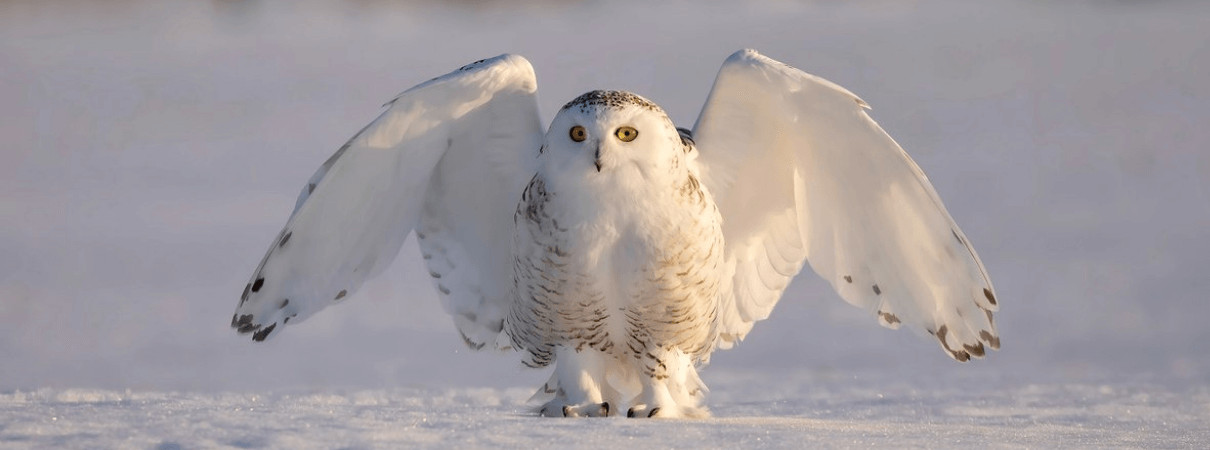 Snowy Owl perched on a snowy landscape
Snowy Owl perched on a snowy landscape
Snowy Owls’ deep, hoarse hoots can be heard from up to seven miles away on the Arctic tundra. Famous for their white plumage, Snowy Owls have a circumpolar range, spanning northern regions of Eurasia and North America. The IUCN Red List categorizes this species as Vulnerable, with significant habitat loss expected due to climate change.
These owls are a symbol of the Arctic wilderness, with their striking white plumage and powerful presence. According to the IUCN, Snowy Owls are facing increasing threats from climate change, habitat loss, and human disturbance. Conservation efforts aimed at protecting their habitat and mitigating the impacts of climate change are essential to ensure their long-term survival.
9.1. The Far-Reaching Hoot
The Snowy Owl’s deep, hoarse hoot can travel great distances, making it a vital communication tool in the vast, open Arctic tundra.
The Snowy Owl’s hoot is a deep, hoarse sound that can be heard from up to seven miles away on a clear night. According to the Cornell Lab of Ornithology, these hoots are used to establish territory and attract mates, and they are most commonly heard during the breeding season. The far-reaching nature of the call is well-suited for the open landscapes of the Arctic tundra.
9.2. Vulnerable Status and Climate Change
Snowy Owls’ Vulnerable status and the threat of habitat loss due to climate change underscore the urgent need for conservation action.
Snowy Owls are facing increasing threats from climate change, habitat loss, and human disturbance. The IUCN Red List categorizes this species as Vulnerable, and research suggests that they could lose up to half of their current North American habitat if the climate warms by 1.5 degrees Celsius. Conservation efforts aimed at mitigating the impacts of climate change and protecting their habitat are essential to ensure the long-term survival of these owls.
10. Elf Owl: Miniature Yips
 Eastern Screech-Owl perched in a tree
Eastern Screech-Owl perched in a tree
The smallest owl in the world, the Elf Owl, lives in the woodlands and deserts of the southwestern U.S. and Mexico. Their “chatter song” consists of a fast series of high-pitched notes, likened to a small dog’s yipping. Now rare in some areas, Elf Owls are declining due to habitat loss and are listed as Endangered in California.
These owls are truly miniature, with a body length of only 5 to 6 inches. According to the U.S. Fish and Wildlife Service, Elf Owls are highly dependent on mature woodlands and deserts with abundant prey and suitable nesting sites. Their populations are declining due to habitat loss, pesticide use, and other factors, and they are listed as Endangered in California.
10.1. The Chatting Song
The Elf Owl’s “chatter song,” a series of high-pitched notes resembling a small dog’s yipping, is a unique and charming vocalization.
The Elf Owl’s “chatter song” is a fast series of five to seven high-pitched notes that sound like a small dog’s yipping. According to the Cornell Lab of Ornithology, these calls are used to establish territory and attract mates, and they are most commonly heard during the breeding season. The distinctive nature of the call makes it a reliable indicator of the presence of Elf Owls in a given area.
10.2. Declining Populations and Habitat Loss
Elf Owls’ declining populations and Endangered status in California underscore the need for habitat conservation and efforts to protect these tiny owls.
Elf Owls are facing increasing threats from habitat loss, pesticide use, and other factors. Their populations are declining throughout their range, and they are listed as Endangered in California. Conservation efforts aimed at protecting and restoring their habitat are essential to ensure the long-term survival of these owls.
11. How to Help Owls: Conservation Actions
Protecting owls requires collective effort. American Bird Conservancy and Joint Venture partners have improved conservation management on 6.4 million acres of U.S. bird habitat. Support this work by making a gift today.
Individual actions can also have a significant impact. Advocate for bird-friendly policies by telling lawmakers to prioritize birds, bird habitat, and bird-friendly measures through ABC’s Action Center.
11.1. Supporting Conservation Organizations
Supporting organizations like the American Bird Conservancy can directly contribute to owl habitat conservation and research efforts.
Conservation organizations play a crucial role in protecting owls and their habitats. By supporting these organizations through donations or volunteer work, you can help fund research, habitat restoration, and other important conservation efforts. The American Bird Conservancy, for example, has a long history of working to protect birds and their habitats, and they offer a variety of ways to get involved.
11.2. Bird-Friendly Living
Simple actions at home, like adding native plants, avoiding pesticides, and keeping cats indoors, can significantly benefit owls and other birds.
Living a bird-friendly life can have a direct and positive impact on owls and other birds. By adding native plants to your garden, you can provide food and shelter for birds and other wildlife. Avoiding pesticides can help protect birds from poisoning and other harmful effects. And keeping cats indoors can prevent them from preying on birds and other small animals. These simple actions can make a big difference in the lives of owls and other birds in your community.
12. Exploring Streetsounds.net: Your Gateway to Urban and Wildlife Sounds
Streetsounds.net offers a unique opportunity to explore the diverse sounds of both urban environments and wildlife, including a wide array of owl calls.
At streetsounds.net, you can immerse yourself in the sounds of the city and the wild, exploring the rich tapestry of urban soundscapes and natural environments. Our extensive library includes a wide variety of owl calls, allowing you to identify different species and learn about their unique vocalizations. Whether you’re a musician, filmmaker, or simply a nature enthusiast, streetsounds.net offers something for everyone.
12.1. Discovering Owl Sounds on Streetsounds.net
Streetsounds.net provides a comprehensive collection of owl sounds, enabling you to identify species, enhance your creative projects, and deepen your appreciation for these nocturnal creatures.
Our collection of owl sounds is curated to provide you with a diverse and informative listening experience. You can browse our library by species, location, or type of call, and you can even download sounds for use in your own creative projects. Whether you’re looking for the deep hoot of a Great Horned Owl or the bloodcurdling shriek of a Barn Owl, you’ll find it on streetsounds.net.
12.2. Urban Soundscapes and Wildlife Blends
Streetsounds.net offers a unique blend of urban and wildlife sounds, allowing you to create innovative soundscapes that capture the essence of both worlds.
Our collection of urban soundscapes includes a wide variety of sounds, from the hustle and bustle of city streets to the quiet hum of suburban neighborhoods. You can combine these sounds with our collection of owl calls to create innovative soundscapes that capture the essence of both the urban and natural worlds. Whether you’re working on a film, a video game, or a music project, streetsounds.net offers the tools and resources you need to bring your vision to life.
By visiting streetsounds.net, you can explore the fascinating world of owl sounds and discover the rich tapestry of urban and natural environments. Our extensive library, expert guidance, and vibrant community make streetsounds.net the perfect destination for anyone interested in sound.
Address: 726 Broadway, New York, NY 10003, United States.
Phone: +1 (212) 998-8550.
Website: streetsounds.net.
FAQ: Decoding Owl Sounds at Night
1. What is the most common owl sound at night?
The most common owl sound at night is the hooting of the Great Horned Owl, often described as a deep “hoo-h’HOO-hoo-hoo.”
2. How can I identify an owl by its call?
You can identify an owl by its call by listening to the specific patterns, tones, and sequences of hoots, screeches, or trills unique to each species. Resources like streetsounds.net offer sound libraries to help with identification.
3. Why do owls make different sounds?
Owls make different sounds to communicate various messages, including territorial claims, mate attraction, warning signals, and maintaining contact with family members.
4. Are owl sounds different in urban areas compared to rural areas?
While the basic calls remain the same, owl sounds in urban areas might be influenced by the surrounding noise levels, potentially leading to altered frequencies or patterns to be heard more clearly.
5. What does it mean when an owl hoots repeatedly?
Repeated hooting often indicates that an owl is establishing or defending its territory, or attempting to attract a mate during the breeding season.
6. Do both male and female owls make the same sounds?
In many owl species, males and females have distinct calls. The male’s call is typically deeper and more resonant, used for attracting a mate, while the female’s call may be higher-pitched.
7. How far can owl sounds travel at night?
Owl sounds can travel varying distances depending on the species and environmental conditions. For example, the deep hoot of a Snowy Owl can be heard up to seven miles away in the open Arctic tundra.
8. Why are owls more vocal at certain times of the year?
Owls are typically more vocal during their breeding season, which usually occurs in late winter and early spring. This is when they are actively establishing territories and attracting mates.
9. Can human activities affect owl sounds and behavior?
Yes, human activities such as habitat destruction, noise pollution, and pesticide use can negatively affect owl sounds and behavior, disrupting their communication and hunting patterns.
10. What should I do if I find an injured owl?
If you find an injured owl, contact a local wildlife rehabilitation center or animal rescue organization immediately. Do not attempt to handle the owl yourself, as they can be dangerous.


